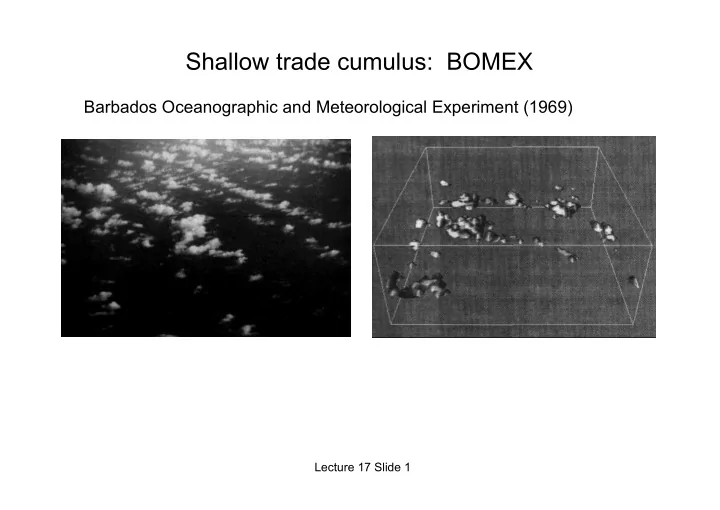

Shallow trade cumulus: BOMEX Barbados Oceanographic and Meteorological Experiment (1969) Lecture 17 Slide 1
LES of nonprecipitating BOMEX trade cumulus Lecture 17 Slide 2
BOMEX LES profiles Lecture 17 Slide 3
Shallow Cu buoyancy/ flux: entrainment dilution reduces b’ and w’ Lecture 17 Slide 4
BOMEX LES profiles • Humidity is fluxed up into the inversion where Cu mix with FT air • Cu flux momentum downshear, but not as efficiently as dry convection. Lecture 17 Slide 5
BOMEX LES profiles Lecture 17 Slide 6
Estimating Cu lateral entrainment rate ε q = − dq tu dz • Lots of entrainment dilution • Shallow Cu updrafts are far q tu − q t from moist-adiabatic Lecture 17 Slide 7
Mass flux and detrainment rate 1 dM dz = ε − δ Many Cu don’t ever reach the inversion M Lecture 17 Slide 8
Randall 1980 Sc to Cu transition • A fundamental feature of the Hadley circulation. • Important to global radiation balance • A challenge for climate models, Net cloud radiative effect because it involves cloud-turbulence interaction that must Sc Cu be parameterized. Lecture 17 Slide 9
LES of Sc to Cu transition • 2D, 4x3 km, Δ x = 50 m, Δ z = 25 m, 8 days • SST = 285 + 1.5 K d -1 , D = 3x10 -6 s -1 , Vg = 7.1 ms -1 • Diurnally-averaged insolation for 30 N. Wyant et al. 1997 Lecture 17 Slide 10
Horizontal-mean statistics Sc Sc over Cu Cu Lecture 17 Slide 11
Sc breakup, decoupling and DIDECUPE DIDECUPE = Deepening-Induced Decoupling and Cumulus Penetrative Entrainment (Wyant et al. 1997) 1. Deeper Sc-capped boundary layers with weaker inversions over warmer water favor persistent decoupling. 2. Decoupling leads to development of a Cu layer, which takes over the entrainment, mixing in enough dry air to evaporate the Sc below the inversion. (Wyant et al. 1997) Lecture 17 Slide 12
Recommend
More recommend